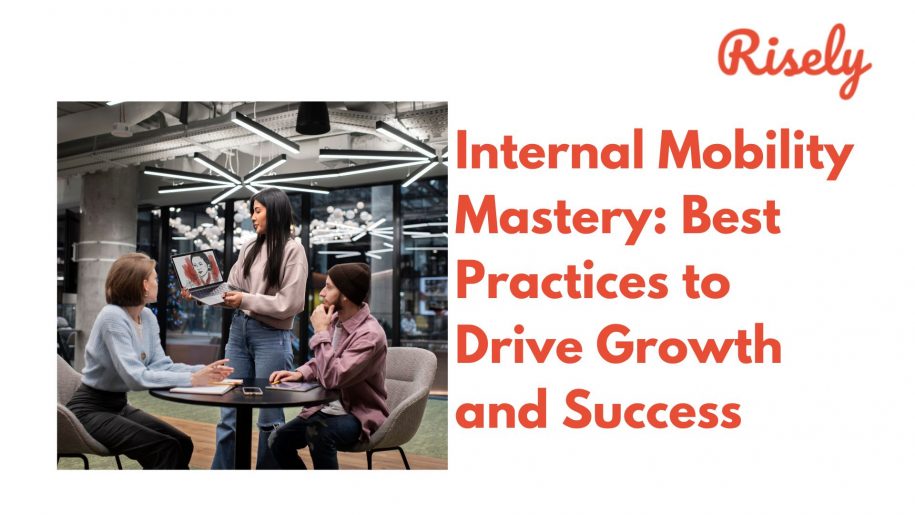Internal Mobility Mastery: Best Practices to Drive Growth and Success
Organizations face the constant challenge of attracting, developing, and retaining top talent. While external recruitment is crucial, another valuable resource often goes untapped within companies – the existing pool of skilled and knowledgeable employees. This is where the concept of internal mobility takes center stage. This blog will discuss internal mobility and its profound impact on employee growth and organizational success. We will navigate the multifaceted realm of it , exploring the benefits, strategies, and best practices that drive its effectiveness.What is internal mobility?
Internal mobility refers to the movement or transition of employees within an organization to different roles, positions, or departments. It involves providing opportunities for employees to grow, develop new skills, and take on new responsibilities without leaving the company. It allows organizations to leverage the existing talent pool and retain valuable employees while enabling individuals to explore new career paths and broaden their experience within the same organization. It is seen as a strategic approach to talent management, fostering employee engagement, development, and long-term career growth.Why is internal mobility important?
Internal mobility is important for several reasons:- Retention of top talent: Offering internal mobility opportunities can help organizations retain their high-performing employees. When employees see a clear path for growth and development within the company, they are more likely to stay, reducing turnover and the associated recruitment and onboarding costs.
- Employee engagement and motivation: It provides new challenges and opportunities, keeping employees engaged and motivated. It helps prevent stagnation, as employees can continuously learn and take on fresh responsibilities, increasing job satisfaction and a sense of purpose.
- Knowledge retention and succession planning: It allows organizations to retain institutional knowledge and expertise by providing pathways for experienced employees to take on leadership or specialized roles. This contributes to smooth succession planning, ensuring a seamless transition of responsibilities and minimizing disruption when key employees retire or move on.
- Skill development and career growth: It enables employees to acquire new skills and expand their knowledge base by exploring different roles or departments. It helps employees build a diverse skill set and opens up opportunities for career advancement within the organization.
- Enhanced collaboration: Employees who work in different areas or teams gain a broader perspective and understanding of the organization. This fosters collaboration, cross-functional knowledge sharing, and a sense of unity as employees develop relationships across various departments, enhancing teamwork and organizational cohesion.
- Cost savings: It can be a more cost-effective talent management strategy compared to external hiring. Organizations save on recruitment and training costs when they promote or move existing employees to new positions. Internal hires tend to have a shorter adjustment period and can ramp up their productivity faster than external hires.
OtherInterestingReads
Types of internal mobility
There are several types of internal mobility that organizations can implement to facilitate employee growth and development. Here are some common types:- Vertical mobility: Vertical mobility involves promotions or advancements within the organizational hierarchy. It includes moving from entry-level to higher-level roles, such as supervisor, manager, or executive.
- Horizontal mobility: Horizontal mobility refers to lateral moves within the organization. Employees transition to different roles or departments at a similar level without significantly changing job titles or seniority. This allows employees to gain new experiences, skills, and perspectives.
- Geographic mobility: Geographic mobility entails transferring employees to different geographical locations or branches of the organization. It can involve relocating to another city or state to work in a different office.
- Skills-based mobility: It focuses on employees acquiring new skills or competencies to transition into different roles or departments. This allows individuals to adapt to changing business needs and take advantage of emerging opportunities within the organization.
What are some best practices for implementing internal mobility effectively within an organization?
Here are some best practices for implementing internal mobility effectively:- Transparent communication: Communicate the opportunities for internal mobility within the organization. Provide employees with information about available positions, career paths, and the skills required for advancement. This transparency fosters a culture of openness and empowers employees to pursue growth opportunities actively.
- Skills assessment and development: Conduct regular skills assessments to identify employees’ strengths, areas for improvement, and interests. Use this information to create personalized development plans that align with employees’ career goals and organizational needs. Offer training programs and coaching to help employees acquire the necessary skills for internal mobility.
- Leadership support and involvement: Gain support and involvement from managers to champion internal mobility initiatives. Leaders should actively advocate for employees’ career development, promote a learning culture, and encourage managers to support and facilitate internal mobility opportunities.
- Employee development discussions: Incorporate discussions about career development and internal mobility into performance evaluations, one-on-one meetings, and development planning sessions. Regularly discuss employees’ aspirations, interests, and potential growth opportunities to ensure alignment between their goals and organizational needs.
- Internal job boards: Implement an internal job posting system or job board that advertises available positions within the organization. Make sure it is easily accessible and regularly updated to provide employees with visibility and equal access to internal opportunities.
- Talent mobility programs: Establish structured talent mobility programs that enable employees to explore different roles, departments, or locations. These programs can include rotation programs, job-shadowing initiatives, and cross-functional project assignments to provide employees with exposure and learning experiences.
- Encourage networking and collaboration: Encourage employees to network across departments and collaborate on cross-functional projects. Facilitate interactions and knowledge sharing to help employees build relationships and develop a broad understanding of the organization.

Internal mobility process
The internal mobility process typically involves several key steps. Here is an outline of the process:- Talent identification: Identify potential internal mobility candidates by assessing their performance, skills, competencies, and career aspirations. This can be done through performance evaluations, skills assessments, and discussions with managers.
- Opportunities exploration: Work with employees to identify their interests and goals. This includes understanding their desired career path, preferred roles, and departments they are interested in exploring.
- Internal job postings: Advertise internal job openings through an internal job posting system. Job postings clearly outline the required qualifications, responsibilities, and expectations.
- Application and selection: Encourage employees to apply for internal positions that align with their interests and qualifications. Implement a fair and transparent selection process, which may involve reviewing applications, conducting interviews, and assessing candidates against the job requirements.
- Assessing fit and development plans: Assess the fit between the candidate and the new role or department. Evaluate the employee’s skills and potential for success in the new position. Develop a personalized development plan to address skill gaps and ensure a smooth transition into the new role.
- Transition and onboarding: Once selected, facilitate a smooth transition for the employee. This may involve providing necessary training, orientation to the new role, and introductions to new colleagues. Ensure that the employee feels supported during the onboarding process.
- Performance monitoring and feedback: Monitor the employee’s performance in their new role and provide regular real time feedback and support. Set clear expectations and goals, and provide opportunities for ongoing development and growth.
- Continuous development and mobility: Encourage continuous learning and development to support ongoing career growth and mobility. Review employees’ career aspirations regularly, identify new growth opportunities, and support their progression.
- Evaluation and adjustment: Continuously evaluate the effectiveness of the internal mobility process and make necessary adjustments. Seek feedback from employees and managers, track outcomes, and refine the process to ensure it aligns with organizational goals and employee needs.
Conclusion
Internal mobility is a powerful catalyst for unleashing the untapped potential within organizations. Throughout this blog, we have explored the transformative nature of internal mobility and its significant impact on employee growth, engagement, and organizational success. By embracing internal mobility, organizations can create a culture that nurtures continuous learning, personal development, and career advancement. This approach enables employees to expand their skills, knowledge, and experiences while driving innovation, collaboration, and adaptability within the organization.Calling all managers!
Discover the power of internal mobility and its impact on your team’s growth
Sign up for a free one-on-one assessment to understand your team’s development goals and skill requirements.
Frequently Asked Questions
What do you mean by internal mobility?
Internal mobility refers to the movement or transition of employees within an organization to different roles, positions, departments, or locations.
What is the purpose of internal mobility?
The purpose of internal mobility is to foster employee growth and engagement while meeting the organization’s talent needs. It enables organizations to leverage their talent pool, retain valuable employees, and fill internal skill gaps.
What is internal movement?
Internal movement refers to employees transitioning from one role to another within the same organization. It encompasses promotions, lateral moves, transfers, and other forms of internal career progression.
What are internal and external mobility?
Internal mobility focuses on developing and retaining talent within the company, whereas external mobility involves attracting new talent from outside the organization.
Other Related Blogs
5 Secrets To Ace Project Manager Training
5 Secrets To Ace Project Manager Training You’ve poured your heart and soul into building a dream team. You’ve recruited talented individuals with diverse skill sets, and you’re confident they…
Performance Management Training: Empowering Managers To Manage Better
Performance Management Training: Empowering Managers To Manage Better Remember that feeling of dread when you knew performance review season was rolling around? Yeah, us, too. For many employees, performance reviews…
Manager Development Goals And How To Reach Them: Opportunities And Areas To Focus On
Manager Development Goals And How To Reach Them: Opportunities And Areas To Focus On You’ve meticulously crafted a development program for your high-potential employees, but their managers just aren’t on…
Leader Competence: The Cornerstone of Effective Leadership Development
Leader Competence: The Cornerstone of Effective Leadership Development Imagine you’re leading a talented team, but somehow, projects are stalling, and motivation seems slipping. You see the potential in your people,…


